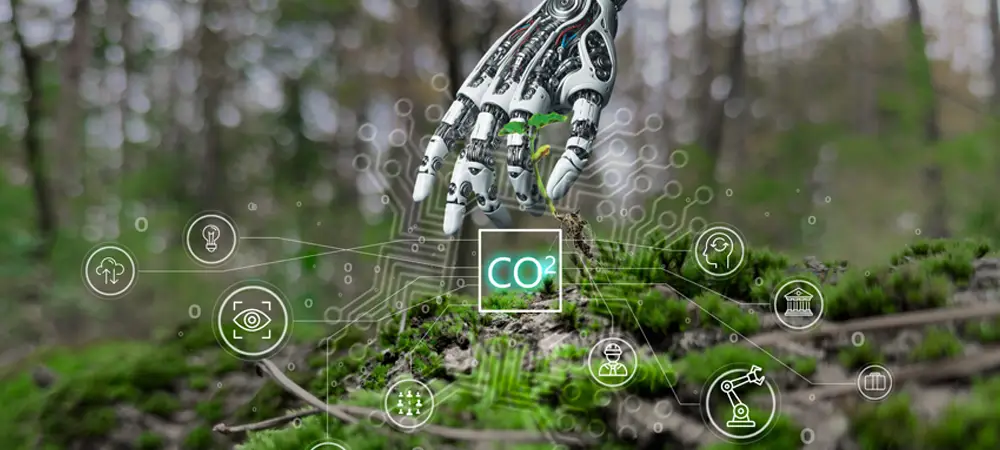AI and Climate Change: Innovations for a Sustainable Future


Climate change is a major damage and this climate change harms urban and natural systems and that has also resulted in over $500 billion in damages to the world economy.
Nowadays, we observe there is a drastic change in climate and temperature globally. Now many factories and industries are coming up and the carbondioxide emitted from the chimneys. Also large-scale carbon dioxide emissions are mostly caused by the heavy use of fossil fuels in manufacturing processes. All these factors affect the climate and also increase the pollution level in atmosphere. This climate change is also linked to sea level rise, increase in the frequency of natural disasters, a decrease in crop production capacity, and a loss of biodiversity.
As many industries are coming up, so forests are being cleared thus decreasing rearing of animals. This intensifies the greenhouse effect and causes global warming by adding massive amounts of greenhouse gases (carbon dioxide) to those that already exist naturally in the atmosphere. The fight against climate change can benefit from the application of artificial intelligence (AI).
Due to the increase in temperature, icebergs start melting and AI has been trained to measure iceberg changes 10,000 times faster than a human could. This will facilitate the scientists to understand the amount of iceberg meltwater released into the ocean. Scientists can observe AI mapping large icebergs in Antarctica in satellite images. For human this task is very hard to identify icebergs in a sea ice.
Tornado detection and prediction by researchers have been accomplished with support vector machines (SVMs). As the environment is non-linear, kernels are used in high dimensional working space that converts the input into the nonlinear space. SVMs are able to learn a linear model in a nonlinear environment. Both Artificial Neural networks (ANNs) and SVMs generate models are flexible and powerful but produce models that are often difficult to interpret in terms of underlying physical concepts.
Another statistical learning method is linear regression has been used in weather forecast. Researchers in one of their paper suggested a regression method to forecast the probability of severe weather and used this model to forecast maximum hail size and large-hail probability.
Apart from these, there are also many other AI based methods like –
decision tree, that can handle large size data, random forest, Gradient boost regression tree.
Few examples are given where AI can help in climate-
A Brazilian firm, uses artificial intelligence (AI) to forecast the location, timing, and nature of climate disasters in São Paulo- like when and where the climate disaster will occur.
Google DeepMind, Google’s AI research laboratory, applied AI to help fight climate change in number of areas.
Additionally, Google is aimed at enhancing weather prediction and raising the value of wind energy through more accurate production prediction from wind farms with AI capabilities.
Real-time prediction of severe wind is another important task for forecasters. Researchers use AI techniques to predict the probability of severe wind within various buffer distances like 0, 5km, 10 km around the storm centre to know the severity of storm after certain distances and also time windows like 0–15, 15–30, 30–45, 45–60, and 60–90 min to predict the probability of wind into the future.
As carbon emission is also a major factor for global warming, AI is also used to help metal, mining, oil and gas companies to decarbonize their operations.
A company in California has developed emission tracking system that combines satellite imagery with data from machines. They found that the system can track, trace and can reduce around 20-30% emissions.
This figure [1] shows the use of artificial intelligence to reduce the effects of global warming. This figure divides the impact of climate change on human social production and life into eight sections and each of which use AI for investigation. The energy efficiency applications of artificial intelligence in this picture includes carbon storage, forecasting for renewable energy, and carbon sequencing. Weather forecasting, industrial process optimization, and energy-efficient building design and retrofitting all make use of this technology.
As we are interested in climate, so AI in natural resource management, precision agriculture, and transportation networks is not mentioned.
[1] Lin Chen aet al., Artificial Intelligence-based solutions for climate change: a review, Environmental Chemistry Letters, vol. 21, 2525-2557, 2023.
Authored By

Dr. TAMALIKA CHAIRA
Associate Professor
Department of CSE
The NorthCap University
